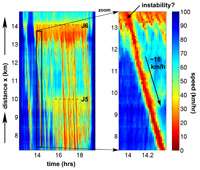Strung along -- easing holiday traffic pain

This Easter, motorists will experience the familiar frustration of being stuck on a motorway in a stop-start traffic jam that eventually disperses with no apparent cause.
Researchers have found that although most changes in vehicle speed and road position get absorbed by traffic flow, they sometimes combine in a 'perfect storm' to create 'phantom' traffic jams. Understanding why this happens is being studied in a project supported by the Engineering and Physical Sciences Research Council (EPSRC) that will lead to better traffic flow forecasting to help prevent congestion.
The project, led by Dr Eddie Wilson from the University of Bristol, has made progress in creating mathematical models for describing phantom traffic jams, or stop-and-go waves in motorway traffic.
Dr Wilson will talk about his research on the BBC One Show on Friday 2 April.
The traffic models have been looked at in a new way using 'string instability' theory to test how good existing computer-based methods are at predicting how traffic flows and queues build up and dissipate.
Dr Wilson says: "The stop-and-go waves are generated by very small events at the level of individual vehicles. There's something about traffic that magnifies small effects to create large changes in certain situations."
He has identified patterns in existing traffic models that will make working on more complicated scenarios possible, and could lead to more accurate forecasting of traffic flow.
The next stage of the project will see the best of these traffic models being combined in a way that allows them to learn from experience and observation. This will give a human-like artificial intelligence to these computer-based ways of forecasting traffic.
The project uses data taken from a particularly busy 10-mile stretch of the M42 near Birmingham that has one of the highest concentrations of traffic monitoring equipment in the world. This means individual vehicles can be tracked through a specially-instrumented one-mile section of this stretch in most traffic conditions to reconstruct their travel paths.
The work is being carried out in collaboration with project partners the Highways Agency, Knowledge Transfer Network for Industrial Mathematics, and TRL.
Traffic - fast facts
• The average road user spends six months of their life in traffic jams
• Road congestion costs the UK economy roughly £7-8 billion a year
• UK road traffic has grown by a quarter in just 20 years
• UK road traffic was forecast to grow by 30% between 2000 and 2015
• According to the CBI employers' group, the cost of road congestion to the economy is likely to more than double by 2025 unless changes are made to working habits, such as staggering commute times.
(Sources: CBI & BBC)

















